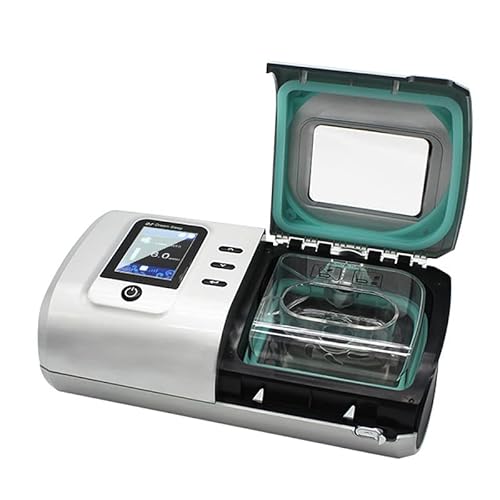Does Using a Cpap Machine Cause Weight Loss? is a vital question for those beginning treatment for Obstructive Sleep Apnea (OSA) and seeking a healthier lifestyle. The general scientific consensus is that CPAP therapy does not directly cause weight loss, but it dramatically improves the body’s metabolic and hormonal function, making successful weight management significantly easier. CPAP serves as a powerful facilitator of weight loss by reversing the physiological damage caused by untreated sleep deprivation.
Does Using a Cpap Machine Cause Weight Loss? The direct answer is no, a CPAP machine is not a weight loss tool in itself; however, treating chronic sleep disruption is proven to stabilize metabolic processes, reduce appetite-stimulating hormones, and increase energy levels, all of which strongly support weight reduction efforts. Successful management of Obstructive Sleep Apnea (OSA) removes a major physiological barrier to achieving and maintaining a healthy body weight.
The Vicious Cycle of Sleep Apnea and Metabolic Dysfunction
Obstructive Sleep Apnea (OSA) is characterized by repeated pauses in breathing during sleep, causing fragmented rest and chronic oxygen deprivation. This constant stress triggers several severe metabolic responses that actively promote weight gain and prevent weight loss.
🛒 Recommended Product
Untreated OSA forces the body into a prolonged state of physiological distress, which manifests through two primary mechanisms:
- Elevated Cortisol Levels: Sleep deprivation, regardless of its cause, is perceived by the body as a stressor. This chronic stress causes the sustained release of cortisol, often known as the “stress hormone.” High cortisol encourages the body to store fat, particularly visceral fat around the abdomen, which is metabolically dangerous.
- Increased Insulin Resistance: Studies published by organizations like the American Diabetes Association consistently link poor sleep quality and oxygen desaturation (hypoxia) to increased insulin resistance. When cells resist insulin, the body must produce more of the hormone, leading to higher circulating blood sugar and greater fat storage. This directly contributes to the development of type 2 diabetes and makes calorie restriction less effective for weight management.
By providing continuous positive airway pressure, CPAP therapy eliminates the breathing pauses and restores consistent oxygenation, effectively ending this nocturnal stress response and allowing the body’s metabolic function to normalize.
How CPAP Therapy Restores Hormonal Balance
One of the most profound ways continuous positive airway pressure (CPAP) facilitates weight loss is by correcting the imbalance of crucial appetite-regulating hormones that are thrown out of sync by severe sleep fragmentation.
Poor sleep impacts the two key hunger hormones: leptin and ghrelin.
- Ghrelin (The Hunger Hormone): Ghrelin tells the brain when it is time to eat. Untreated sleep apnea causes ghrelin levels to rise, leading to increased appetite, cravings for high-calorie, carbohydrate-rich foods, and difficulty feeling satisfied after meals.
- Leptin (The Satiety Hormone): Leptin signals to the brain that the body has sufficient energy and that the person should stop eating. Untreated OSA causes leptin levels to drop, meaning the brain receives fewer signals of fullness, resulting in overeating.
Treatment adherence to CPAP reverses this destructive imbalance. According to a 2013 study in the journal Sleep, patients using CPAP consistently saw their leptin levels rise and their ghrelin levels fall, bringing them back into a healthy range. This fundamental change in appetite regulation makes controlling caloric intake—the core requirement of any weight loss plan—much easier and more sustainable.
| Hormonal Impact Comparison | Untreated Sleep Apnea | Effective CPAP Therapy |
|---|---|---|
| Cortisol (Stress) | Elevated (Promotes visceral fat storage) | Normalized (Reduces stress response) |
| Ghrelin (Appetite Stimulant) | Increased (Leads to high caloric intake) | Decreased (Reduces hunger and cravings) |
| Leptin (Satiety Signal) | Decreased (Leads to overeating) | Increased (Promotes feeling of fullness) |
| Insulin Sensitivity | Reduced (Increases risk of diabetes) | Improved (Stabilizes blood sugar control) |
Increased Energy Expenditure and Physical Activity
Perhaps the most direct contributor to enabling weight loss via CPAP is the drastic improvement in daytime energy levels. A hallmark symptom of OSA is severe daytime fatigue and exhaustion.
🛒 Recommended Product
When patients are constantly tired:
1. They lack the motivation or energy to engage in physical exercise.
2. They burn fewer calories throughout the day (low non-exercise activity thermogenesis or NEAT).
3. They may consume more caffeine and sugar to compensate for the lack of restful sleep, further disrupting metabolism.
Effective CPAP usage provides truly restorative sleep. Patients who use their continuous positive airway pressure machine consistently report significantly higher energy levels. This renewed vitality directly translates into the ability to adhere to exercise routines, take longer walks, and maintain higher daily activity levels.
For individuals wondering Does Using a Cpap Machine Cause Weight Loss? the answer lies in the restored ability to move the body and burn calories. Research indicates that treating OSA significantly boosts physical function scores and reduces reported fatigue, which is a necessary precursor for any successful diet and exercise regimen.
CPAP Adherence and BMI Reduction: What the Research Shows
While CPAP does not act as a gastric bypass, specific studies have tracked Body Mass Index (BMI) changes in compliant patients:
- Weight Stabilization: For many patients, the immediate benefit of CPAP is weight stabilization, preventing the continued, insidious weight gain often associated with the metabolic disruption of OSA.
- Facilitated Weight Loss: A comprehensive review found that while CPAP alone might only lead to minor, spontaneous weight loss (often just a few pounds), it dramatically enhances the efficacy of concurrent dietary and lifestyle interventions. Patients who successfully use CPAP and simultaneously implement a calorie-controlled diet consistently achieve greater and faster weight loss than non-compliant patients or those with untreated sleep apnea.
- Improved Treatment Outcomes: Because excess body weight, particularly around the neck, often contributes to the severity of Obstructive Sleep Apnea, even modest weight loss achieved through better energy and diet control can lower the necessary pressure settings on the CPAP machine, making therapy more comfortable and encouraging further adherence. This creates a positive feedback loop leading to sustained health improvements.
The key determinant in deriving weight loss benefits from CPAP is treatment adherence. The therapeutic benefits (hormonal regulation, lowered cortisol, improved energy) only occur when the device is used for the recommended 6-8 hours nightly. Patients who fail to use the machine consistently will continue to suffer the negative metabolic consequences of chronic sleep fragmentation.
CPAP therapy, therefore, should be viewed as essential metabolic groundwork. It stabilizes the hormonal environment, allowing the patient’s own efforts—diet, exercise, and lifestyle changes—to finally yield the desired results.
🛒 Recommended Product
In summary, while Does Using a Cpap Machine Cause Weight Loss? is technically answered with a ‘no,’ the machine is an invaluable and necessary tool for correcting the debilitating metabolic dysfunctions caused by Obstructive Sleep Apnea, thereby creating the optimal physiological environment for successful and sustained weight reduction. Consistent use of continuous positive airway pressure empowers patients to take control of their activity and diet, leading to improved BMI and better overall health outcomes.
Scientific References & Research
The following peer-reviewed research papers provide additional scientific context:
-
KE Lewis et al. (2004).
Early predictors of CPAP use for the treatment of obstructive sleep apnea
[External Link] -
K Askland et al. (1996).
Educational, supportive and behavioural interventions to improve usage of continuous positive airway pressure machines in adults with obstructive sleep apnoea
[External Link] -
I Smith et al. (2009).
Pressure modification for improving usage of continuous positive airway pressure machines in adults with obstructive sleep apnoea
[External Link]
Note: External research links are provided for educational purposes and do not necessarily represent endorsement.
Frequently Asked Questions About Does Using a Cpap Machine Cause Weight Loss?
Q. How does CPAP usage indirectly support weight management efforts?
A. By effectively treating OSA, CPAP restores normal sleep architecture, reducing daytime fatigue and improving mental clarity. This increase in energy makes patients more likely to adhere to exercise routines and make healthier food choices throughout the day, both of which are critical components of successful weight management. Furthermore, improved sleep helps regulate hormones like ghrelin and leptin, which control appetite and satiety.
Q. Can CPAP therapy affect the levels of hormones that regulate hunger and metabolism?
A. Yes, poor sleep quality characteristic of untreated OSA disrupts the endocrine system, specifically leading to increased levels of the hunger hormone ghrelin and decreased levels of the satiety hormone leptin. Consistent CPAP use can help normalize sleep patterns, which in turn aids in regulating these appetite-controlling hormones, potentially reducing cravings and overeating.
Q. Why might some patients experience initial weight gain after starting CPAP rather than weight loss?
A. Some patients report slight weight gain initially because their bodies are finally able to utilize calories more efficiently once the high metabolic stress caused by constant sleep interruptions is relieved. Before CPAP, the body was working harder due to repeated oxygen dips, burning more calories; once stable sleep is achieved, the basal metabolic rate might slightly decrease, requiring dietary adjustments to prevent weight gain.
Q. If weight loss is not guaranteed, what is the primary health benefit CPAP provides regarding metabolic health?
A. The primary metabolic benefit of CPAP is the improvement of insulin sensitivity and reduction of systemic inflammation, both of which are often impaired by chronic OSA. By improving oxygenation and reducing sympathetic nervous system activity during sleep, CPAP helps mitigate metabolic syndrome risk factors, even if it doesn’t directly cause a drop on the scale. This optimization of metabolic health is crucial for overall long-term well-being.
Q. Are individuals with severe sleep apnea more likely to see weight loss results from CPAP than those with mild apnea?
A. Individuals with more severe OSA often have more pronounced metabolic and hormonal dysregulation, meaning they have a greater potential for improvement once CPAP treatment is initiated. While the CPAP machine itself doesn’t cause weight loss, the restoration of robust sleep quality in these severe cases provides a stronger foundation for successful dietary and physical activity interventions. However, weight loss remains dependent on active lifestyle changes regardless of the initial severity of apnea.
Related Articles
What Is the Best Workout Machine for Weight Loss?
Trying to determine what is the best workout machine for weight loss? While several options deliver results, the rowing machine often provides the max…
Do Vibrating Weight Loss Machines Work?
Do vibrating weight loss machines work? The scientific data is clear: while these vibration therapy plates offer proven benefits like muscle stimulati…
Treadmill Workouts for Buttocks: Sculpt and Tone Your Glutes
Getting fit and shaping your buttocks can be challenging. Treadmill workouts might be the solution you need. Treadmill workouts are not just for cardi…
When you purchase a product through Amazon links on EllipticalKing.com, we may earn a small commission at no extra cost to you. This helps support the site and keep our content free.




